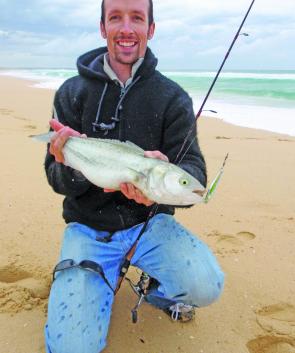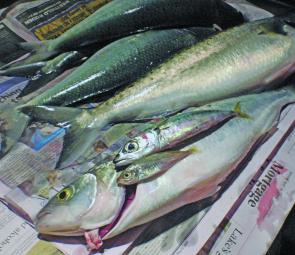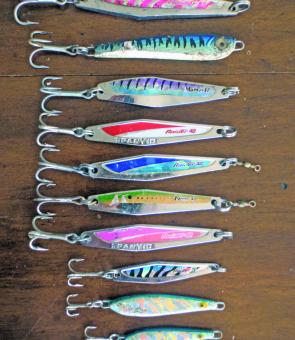During the cooler months the estuaries slow down and keen anglers are increasingly drawn to other forms of fishing to scratch the proverbial itch. One of the most enjoyable and rewarding of these Winter endeavours is spinning for salmon off the beach.
Armed with a bream-style outfit and a selection of small metal lures, one can have a lot of fun. It’s a successful and exciting form of sportfishing that, somewhat surprisingly, hasn't taken off as much as it might have. This article will explore some of the techniques I have learnt in the hope that it will help the beginner catch a few fish or the expert diversify his or her skills.
The Australian salmon is a sleek predatory species that frequents ocean beaches, bays, headlands and occasionally estuaries. The salmon is built for hunting baitfish, with a broad, muscular body, big eyes and short, raspy teeth.
While baitfish are their preferred prey, this voracious, opportunistic hunter will also eat crabs, prawns, worms, fish flesh, cephalopods and most other fresh morsels they come across.
Salmon stocks were hit hard during much of last century, when commercial netting operations took the large, easily caught schools that migrate north every Winter. Many of these fish ended up as cat food.
Due to the closure of the Eden cannery and decisions to ease commercial netting in the 1990s, the stocks have recovered. Commercial catch rates are again at historically high levels, although stocks appear to be relatively healthy.
One of the nicest things about spinning for salmon off the beach is that you can do it using an average estuary outfit. Many people raise their eyebrows when they see you pulling in big salmon on bream gear, but it's surprisingly easy.
They still put up an awesome fight and you'll lose quite a few fish but many to around 3kg are easily landed, partly due to recent advancements in reel technology and the advent of quality braided line.
A smooth drag is a feature on most decent reels and with the diameter and breaking strength we're seeing with braided lines, all you have to do is secure a good hook-up and you'll have a good chance at landing the fish.
However, salmon are acrobatic, unpredictable and sometimes dirty fighters and many hooks are thrown due to their leaps and headshakes.
I use a 7’ medium action graphite rod with a good 3000-size reel with 8lb braid and about a metre of 10lb leader.
If you want to land more fish, upgrade to a whippy 8’ rod and a 4000 or 5000 size reel with 10lb braid and 15lb leader.
Either of these outfits should cast a 30g to 40g slug 60 m or more.
The most important thing is to find a gutter, basically a deeper section of water, usually parallel to the beach, with a sandbar at the back and an opening to the ocean at one or both ends.
Gutters have darker, deeper water and waves generally won't be breaking over them. Often you will see a hole at one end, with a ruffled rip heading out to sea with a trail of foamy, flatter water extending out the back.
Most salmon will be caught in gutters. While you shouldn't let this deter you from trying other areas, there are a few reasons why salmon prefer gutters.
The deeper water provides shelter from larger predators and birds. The gutter’s opening enables the fish to move in and out with ease and the gutter is generally where any food that has been dislodged by the waves will end up.
I have found that the most consistent spot in any gutter is at the back about halfway along, where there is a nice covering of whitewater that is not too churned up. The whitewater provides cover and in this spot the fish have first pick at food that flows off the sandbar.
This is also the spot where the wave action and current aren’t too strong, enabling the fish to conserve energy.
There are days when fish are distributed throughout the gutter and other days when they simply aren't there. After a while, you'll get a feel for whether the beach looks 'fishy' or not and where the best spots are.
There are some days when I walk to the top of the dunes, have a look and turn around and get back in the car.
These are generally the low- and high-energy days.
Salmon generally don't like situations when there is little or no wave energy. The absence of waves means that there is little or no cover for salmon and prey and there is nothing to churn up the sand and dislodge food.
Low-energy days usually coincide with fine weather, which the salmon don't like as much as inclement, overcast weather.
The best thing you can do to maximise your chance of success in low-energy situations is to cover ground. Being mobile and having only one or two casts in each spot means that you will generally find a fish somewhere along a beach.
Learn to use your eyes. If you arrive at the back of the dunes to see a low-energy beach but spot large, black patches of fish swimming along, it's probably worth a few casts! A pair of polarised sunglasses is extremely handy when beach spinning.
Salmon can often be caught on low energy days off headlands, breakwalls and jetties. The deeper water in these areas provides more shelter and varied prey options, so try a breakwall or headland when you can't find fish on the beach.
High-energy situations – crashing waves, whitewater, foam and churned sand – can make fishing extremely difficult.
Generally, fish are present in high-energy situations but will be concentrated in the lower-energy areas. Deeper holes and gutters are the best places to focus.
Due to the sand and foam in the water, it pays to slow your retrieve to keep the lure lower in the water.
Try a large, scented plastic and retrieve it through the deeper holes with a few small twitches here and there.
The best conditions for spinning for salmon are when there is enough energy to create good structure and cover on the beach, while not being too high to churn up the water.
After a while you'll get a feel for what these situations look like. They might become obvious due to the large number of fish you catch.
But it's when conditions are tough that you can learn the most – a lesson applicable to all forms of fishing.
Although one gutter might look the same as the next, plenty of times virtually all the fish on one beach have been holed up in one out of 20 or 30 gutters. Only by moving around have I found them and turned an average day into a hot session.
Another important lesson is to vary your retrieves.
A medium-paced retrieve works on some days, whereas a super-fast crank to skip the lure along the surface is all that works on other occasions. Watching a school of black-backed salmon jostling to eat the lure in a spray of whitewater is an image forever burned into my psyche.
Slowing down the lure right behind the shore break often results in a hook-up. I guess the theory is the following fish realises the prey is about to get away.
Be confident with the lure you are using. If you think it lure will catch fish, it generally will.
If it looks tired and the hooks are blunt, try changing. This is particularly important when the fishing is tough.
I have had the most success with Spanyid Raiders, SureCatch Knights, Silstar Psykos, Halcos and Lazers, but pretty much anything flashy with decent hooks and split rings will catch fish.
Sometimes it pays to upgrade the hooks and split rings and I have found that a small swivel attached to the top split ring saves a lot of bust-offs.
While most fish generally hook themselves, it can pay to strike firmly to set the hook when fishing with lighter gear. The large gauge of some of the trebles fitted on popular brands may need a bit of force to penetrate the hard, cartilaginous mouth of the fish.
– Lee Georgeson, www.fishinginsoutheastaustralia.wordpress.com
Facts
PREPARING, COOKING
Salmon are most underrated table fish. They should be bled promptly after capture, which involves inserting the fingers under the gills, placing your thumb on the fish's head and snapping back sharply. This kills the fish instantly and severs the main artery. Fish should be placed head down in the sand or esky to enable the blood to drain.
Filleting and skinning is easy. Then remove bones by cutting a ‘V’ down the centre of the thick section of the fillet. You will then be left with a lovely boneless fillet packed with healthy omega oils. Some people like to remove the darker flesh, which is more strongly flavoured.
The best ways I have eaten salmon are barbecued with Asian sauce (soy, garlic, chilli and honey), in a green curry or in fish cakes.
Battered or crumbed is also delicious, but this method is generally suited to smaller fish around a kilo. The bigger fish are generally better for curries and fish cakes. Soaked in brine and hot-smoked, salmon are also fantastic. – LG

Graham Fifield with a nice salmon taken on light gear and a 40g SureCatch Knight.

A perfect scenario for spinning for salmon off the beach. Good wave energy, an offshore wind and an approaching storm. When storms like this are impending, be mindful that you’re waving around a very effective graphite lightning conductor!

Salmon are voracious predators. This fish had this decent-sized slimy mackerel and a small yellowtail in its stomach.

Excellent salmon conditions. Good wave energy, whitewater cover and overcast weather.

Haywards Beach, north of Bermagui, on a low-energy day when the salmon weren’t at home – but they could have been.

A large school of salmon spotted off a headland (Photo: Graham Fifield)

It’s worth upgrading your salmon spinning lures with swivels. This will help avoid any problems with line twist and will result in less bust-offs and cast-offs.

A typical selection of lures suitable for spinning for salmon off the beach.




